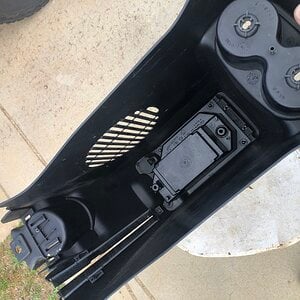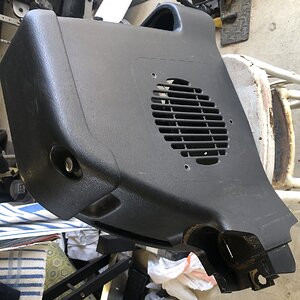ngsm13 5,000+ posts
BSEE
This is a simple EDU I wrote up in a few minutes.
To design a ported box:
You need to know how to perform simple algebra. This assumes .75" MDF, and a slot port using one of the box walls as a port wall. //content.invisioncic.com/y282845/emoticons/fyi.gif.9f1f679348da7204ce960cfc74bca8e0.gif
Use WinISD Pro, don't pay any attention to the driver selection or graph. They're useless. Pick an arbitrary driver.
Terms:
NET Volume: This is the volume your subwoofer actually "sees". NET volume is AFTER you subtract all displacements (port displacement, driver displacement, wood displacment, bracing, etc...).
GROSS Volume: This is total volume, including all displacements. What space the box actually takes up. This is NET Volume PLUS all displacements.
Port Area: The Width and Height of the port, multiplied together. This is 2dimensional, hence the term area.
1. Figure desired NET volume, port area, and tuning.
2. Write down max, or desired Width x Height x Depth.
3. Pick the dimension of 2 sides you want, and leave the third side as a variable. (s) Multiply the two sides together and write this off to the side.
4. Open up WinISD, and pick an arbitrary driver. Continue to ported.
5. Type in your desired box volume, this is the NET Volume, as well as desired tuning.
6. Go to vent tab, click on the circle symbol to change it to a square. (this is for slot port). Type in desired port dimensions (for desired port area). It will give you the needed port length. Write this down.
7. This is where simple algebra comes in. Take the port width and add .75" to it for the port wall. Now find out the volume of the port. Do this by multiplying: (Width(+.75) * Height * Length) / 1728 | This is your port displacement. Write this down.
8. Take your NET volume, add port displacement, add sub displacement, add any other displacements (bracing, etc.) This is you internal GROSS volume. This is how big the box needs to be internally for correct NET volume and tuning. Write this down.
9. More Algebra. You will be solving the following algrebraic equation for (s), this will give you the internal dimension of the last side (the variable you chose.) Actually, here is the equation solved for (s).
Equation:
S = (GrossVolume * 1728) / (Product of remaining two sides)
Voila. You have the internal dimensions, NET Volume, port area, port length, and tuning for your enclosure.
//content.invisioncic.com/y282845/emoticons/smile.gif.1ebc41e1811405b213edfc4622c41e27.gif.
Any questions, let feel free to ask via PM or AIM: ngbd13
nG
To design a ported box:
You need to know how to perform simple algebra. This assumes .75" MDF, and a slot port using one of the box walls as a port wall. //content.invisioncic.com/y282845/emoticons/fyi.gif.9f1f679348da7204ce960cfc74bca8e0.gif
Use WinISD Pro, don't pay any attention to the driver selection or graph. They're useless. Pick an arbitrary driver.
Terms:
NET Volume: This is the volume your subwoofer actually "sees". NET volume is AFTER you subtract all displacements (port displacement, driver displacement, wood displacment, bracing, etc...).
GROSS Volume: This is total volume, including all displacements. What space the box actually takes up. This is NET Volume PLUS all displacements.
Port Area: The Width and Height of the port, multiplied together. This is 2dimensional, hence the term area.
1. Figure desired NET volume, port area, and tuning.
2. Write down max, or desired Width x Height x Depth.
3. Pick the dimension of 2 sides you want, and leave the third side as a variable. (s) Multiply the two sides together and write this off to the side.
4. Open up WinISD, and pick an arbitrary driver. Continue to ported.
5. Type in your desired box volume, this is the NET Volume, as well as desired tuning.
6. Go to vent tab, click on the circle symbol to change it to a square. (this is for slot port). Type in desired port dimensions (for desired port area). It will give you the needed port length. Write this down.
7. This is where simple algebra comes in. Take the port width and add .75" to it for the port wall. Now find out the volume of the port. Do this by multiplying: (Width(+.75) * Height * Length) / 1728 | This is your port displacement. Write this down.
8. Take your NET volume, add port displacement, add sub displacement, add any other displacements (bracing, etc.) This is you internal GROSS volume. This is how big the box needs to be internally for correct NET volume and tuning. Write this down.
9. More Algebra. You will be solving the following algrebraic equation for (s), this will give you the internal dimension of the last side (the variable you chose.) Actually, here is the equation solved for (s).
Equation:
S = (GrossVolume * 1728) / (Product of remaining two sides)
Voila. You have the internal dimensions, NET Volume, port area, port length, and tuning for your enclosure.
//content.invisioncic.com/y282845/emoticons/smile.gif.1ebc41e1811405b213edfc4622c41e27.gif.
Any questions, let feel free to ask via PM or AIM: ngbd13
nG


